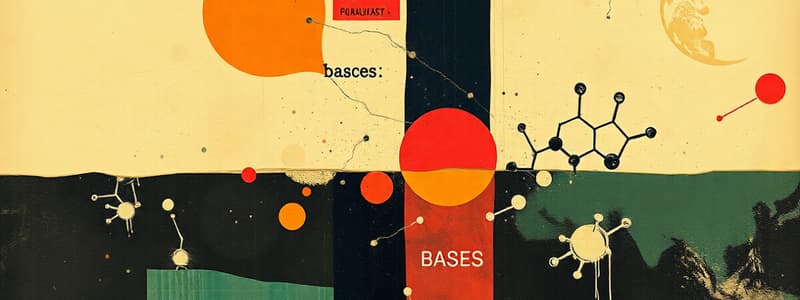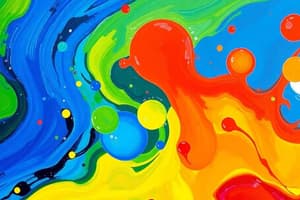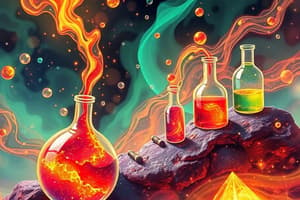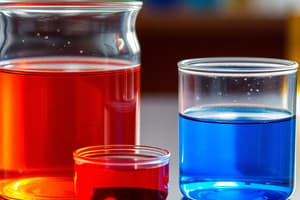Podcast
Questions and Answers
Acids generally have what kind of taste?
Acids generally have what kind of taste?
- Sour (correct)
- Sweet
- Salty
- Bitter
What color does blue litmus paper turn in the presence of an acid?
What color does blue litmus paper turn in the presence of an acid?
- Blue
- Green
- Red (correct)
- Yellow
What color does red litmus paper turn in the presence of a base?
What color does red litmus paper turn in the presence of a base?
- Green
- Yellow
- Blue (correct)
- Red
What type of indicator is litmus?
What type of indicator is litmus?
From what organism is litmus extracted?
From what organism is litmus extracted?
What color is litmus solution when it is neither acidic nor basic?
What color is litmus solution when it is neither acidic nor basic?
Turmeric is what kind of indicator?
Turmeric is what kind of indicator?
What color does a curry stain on white cloth turn when soap is applied?
What color does a curry stain on white cloth turn when soap is applied?
Methyl orange is an example of what kind of indicator?
Methyl orange is an example of what kind of indicator?
If a solution changes red litmus paper to blue, which of the following is most likely true?
If a solution changes red litmus paper to blue, which of the following is most likely true?
Which of the following best describes the function of an acid-base indicator?
Which of the following best describes the function of an acid-base indicator?
A solution is tested with both methyl orange and phenolphthalein. Methyl orange turns yellow, and phenolphthalein remains colorless. What can you conclude about the solution?
A solution is tested with both methyl orange and phenolphthalein. Methyl orange turns yellow, and phenolphthalein remains colorless. What can you conclude about the solution?
Why is it not advisable to determine whether a substance is an acid or a base by tasting it?
Why is it not advisable to determine whether a substance is an acid or a base by tasting it?
Which of these plants is the source of litmus?
Which of these plants is the source of litmus?
What would happen if you mixed a strong acid with a strong base in equal amounts?
What would happen if you mixed a strong acid with a strong base in equal amounts?
A drop of an unknown solution is placed on red cabbage leaf extract, and the extract turns greenish-yellowish. This indicates that the solution is likely:
A drop of an unknown solution is placed on red cabbage leaf extract, and the extract turns greenish-yellowish. This indicates that the solution is likely:
Why are indicators useful in chemical reactions?
Why are indicators useful in chemical reactions?
A curry stain turns reddish-brown when soap is applied. What does this indicate about the nature of soap?
A curry stain turns reddish-brown when soap is applied. What does this indicate about the nature of soap?
Which of the following is a characteristic property of acids?
Which of the following is a characteristic property of acids?
A chemist discovers a new species of lichen that produces a novel dye. Preliminary tests show the dye is purple at pH 7, turns yellow in acidic solutions, and blue in basic solutions. Which of the following is the LEAST reasonable conclusion?
A chemist discovers a new species of lichen that produces a novel dye. Preliminary tests show the dye is purple at pH 7, turns yellow in acidic solutions, and blue in basic solutions. Which of the following is the LEAST reasonable conclusion?
A student performs an experiment where they mix two clear, colorless solutions. They observe the solution turning yellow. Without further testing equipment, what can they conclude?
A student performs an experiment where they mix two clear, colorless solutions. They observe the solution turning yellow. Without further testing equipment, what can they conclude?
Which statement is most accurate regarding the use of natural indicators versus synthetic indicators?
Which statement is most accurate regarding the use of natural indicators versus synthetic indicators?
A solution of unknown pH is tested with red cabbage extract. The extract turns a vibrant blue. Based on this observation, what can you definitively conclude about the solution?
A solution of unknown pH is tested with red cabbage extract. The extract turns a vibrant blue. Based on this observation, what can you definitively conclude about the solution?
A textile chemist is trying to determine whether a newly synthesized fabric is acid-resistant or base-resistant. They decide to test it using natural indicators. What is the most significant limitation of using natural indicators for this purpose?
A textile chemist is trying to determine whether a newly synthesized fabric is acid-resistant or base-resistant. They decide to test it using natural indicators. What is the most significant limitation of using natural indicators for this purpose?
An experiment involves titrating a weak acid with a strong base. Which indicator would be MOST appropriate to use to accurately determine the endpoint of this titration?
An experiment involves titrating a weak acid with a strong base. Which indicator would be MOST appropriate to use to accurately determine the endpoint of this titration?
A lab technician spills a large amount of strong acid on the floor. According to the information provided, which action would be the MOST appropriate FIRST step in neutralizing the spill?
A lab technician spills a large amount of strong acid on the floor. According to the information provided, which action would be the MOST appropriate FIRST step in neutralizing the spill?
Litmus paper is dipped into a solution, but no color change is observed. What is the most logical conclusion?
Litmus paper is dipped into a solution, but no color change is observed. What is the most logical conclusion?
A florist wants to ensure that the hydrangeas they are growing produce blue flowers. Based on your knowledge of acid-base indicators, what should they do to the soil pH?
A florist wants to ensure that the hydrangeas they are growing produce blue flowers. Based on your knowledge of acid-base indicators, what should they do to the soil pH?
A researcher discovers a new flower species. They extract a dye from its petals and find that the dye is pink in acidic solutions but colorless in basic solutions. How could this dye be most effectively utilized?
A researcher discovers a new flower species. They extract a dye from its petals and find that the dye is pink in acidic solutions but colorless in basic solutions. How could this dye be most effectively utilized?
Consider a scenario where a novel extremophile lichen species is discovered in a highly alkaline environment. This lichen produces a unique compound that researchers suspect could function as a natural acid-base indicator. What experimental design would be MOST effective for characterizing the full range and sensitivity of this compound as an indicator?
Consider a scenario where a novel extremophile lichen species is discovered in a highly alkaline environment. This lichen produces a unique compound that researchers suspect could function as a natural acid-base indicator. What experimental design would be MOST effective for characterizing the full range and sensitivity of this compound as an indicator?
A research team is investigating the use of anthocyanins extracted from Hydrangea macrophylla petals as a potential natural indicator for monitoring soil pH in a large-scale agricultural project. Considering the inherent limitations of natural indicators, which of the following strategies would MOST effectively address the challenges of reproducibility and standardization in field applications?
A research team is investigating the use of anthocyanins extracted from Hydrangea macrophylla petals as a potential natural indicator for monitoring soil pH in a large-scale agricultural project. Considering the inherent limitations of natural indicators, which of the following strategies would MOST effectively address the challenges of reproducibility and standardization in field applications?
In a complex chemical process involving multiple reaction steps, the precise control of pH is critical for optimizing the yield of the final product. However, the reaction mixture is highly colored and contains several interfering substances that render traditional acid-base indicators ineffective. Which advanced analytical technique would provide the MOST accurate and reliable means of real-time pH monitoring under these challenging conditions?
In a complex chemical process involving multiple reaction steps, the precise control of pH is critical for optimizing the yield of the final product. However, the reaction mixture is highly colored and contains several interfering substances that render traditional acid-base indicators ineffective. Which advanced analytical technique would provide the MOST accurate and reliable means of real-time pH monitoring under these challenging conditions?
A novel chemical sensor is being developed based on a polymer film doped with a pH-sensitive dye. The sensor's performance is evaluated by measuring the fluorescence intensity of the dye at various pH levels. If the dye exhibits significant photobleaching upon prolonged exposure to excitation light, which of the following strategies would BEST improve the sensor's long-term stability and accuracy?
A novel chemical sensor is being developed based on a polymer film doped with a pH-sensitive dye. The sensor's performance is evaluated by measuring the fluorescence intensity of the dye at various pH levels. If the dye exhibits significant photobleaching upon prolonged exposure to excitation light, which of the following strategies would BEST improve the sensor's long-term stability and accuracy?
In a scenario where a forensic scientist is analyzing soil samples from a crime scene, trace amounts of acidic or basic substances could provide crucial evidence. However, the soil matrix contains a complex mixture of organic and inorganic compounds that can interfere with traditional indicator methods. Which sophisticated analytical technique would be MOST suitable for accurately determining the presence and concentration of specific acidic or basic compounds in the soil sample?
In a scenario where a forensic scientist is analyzing soil samples from a crime scene, trace amounts of acidic or basic substances could provide crucial evidence. However, the soil matrix contains a complex mixture of organic and inorganic compounds that can interfere with traditional indicator methods. Which sophisticated analytical technique would be MOST suitable for accurately determining the presence and concentration of specific acidic or basic compounds in the soil sample?
A researcher is studying the effects of acid rain on ancient marble statues. The researcher wants to use a minimally invasive technique to assess the degree of chemical alteration on the surface of the marble. Which of the following methods would be MOST appropriate?
A researcher is studying the effects of acid rain on ancient marble statues. The researcher wants to use a minimally invasive technique to assess the degree of chemical alteration on the surface of the marble. Which of the following methods would be MOST appropriate?
Consider a scenario where an analytical chemist is tasked with developing a highly sensitive and selective method for detecting trace amounts of a novel organic acid in a complex biological matrix. The acid possesses no inherent chromophoric or fluorophoric properties. Which of the following analytical strategies would be MOST appropriate for achieving the desired detection capabilities?
Consider a scenario where an analytical chemist is tasked with developing a highly sensitive and selective method for detecting trace amounts of a novel organic acid in a complex biological matrix. The acid possesses no inherent chromophoric or fluorophoric properties. Which of the following analytical strategies would be MOST appropriate for achieving the desired detection capabilities?
In microbial ecology, understanding the pH dynamics within a biofilm is crucial. Traditional pH indicators often fail to provide spatially resolved data within the complex 3D structure of biofilms. Which advanced imaging technique would be MOST suitable for mapping the pH distribution with high spatial resolution within a living biofilm?
In microbial ecology, understanding the pH dynamics within a biofilm is crucial. Traditional pH indicators often fail to provide spatially resolved data within the complex 3D structure of biofilms. Which advanced imaging technique would be MOST suitable for mapping the pH distribution with high spatial resolution within a living biofilm?
A team of chemical engineers is designing a microfluidic reactor for a pH-sensitive enzymatic reaction. Precise control and monitoring of pH within the microchannels are crucial for optimizing reaction efficiency. Considering the challenges associated with miniaturization, which of the following pH sensing strategies would be MOST appropriate for real-time monitoring within the microfluidic device?
A team of chemical engineers is designing a microfluidic reactor for a pH-sensitive enzymatic reaction. Precise control and monitoring of pH within the microchannels are crucial for optimizing reaction efficiency. Considering the challenges associated with miniaturization, which of the following pH sensing strategies would be MOST appropriate for real-time monitoring within the microfluidic device?
A researcher aims to create a stimuli-responsive hydrogel material that undergoes a sharp volume change at a specific pH. To achieve this, they need to incorporate a functional group into the hydrogel network that exhibits a significant change in charge state within a narrow pH range. Which of the following functional groups would be the MOST suitable choice for this application?
A researcher aims to create a stimuli-responsive hydrogel material that undergoes a sharp volume change at a specific pH. To achieve this, they need to incorporate a functional group into the hydrogel network that exhibits a significant change in charge state within a narrow pH range. Which of the following functional groups would be the MOST suitable choice for this application?
Flashcards
Acids
Acids
Substances that have a sour taste and turn blue litmus red.
Bases
Bases
Substances that have a bitter taste and turn red litmus blue.
Litmus paper
Litmus paper
A natural indicator used to test acidity or basicity by changing color.
Indicators
Indicators
Signup and view all the flashcards
Reaction of acids and bases
Reaction of acids and bases
Signup and view all the flashcards
Natural indicators
Natural indicators
Signup and view all the flashcards
Synthetic indicators
Synthetic indicators
Signup and view all the flashcards
Turmeric as an indicator
Turmeric as an indicator
Signup and view all the flashcards
pH scale
pH scale
Signup and view all the flashcards
Curry stain example
Curry stain example
Signup and view all the flashcards
Acidity remedy
Acidity remedy
Signup and view all the flashcards
Litmus color change
Litmus color change
Signup and view all the flashcards
Turmeric stain effect
Turmeric stain effect
Signup and view all the flashcards
Purple litmus
Purple litmus
Signup and view all the flashcards
Synthetic vs Natural indicators
Synthetic vs Natural indicators
Signup and view all the flashcards
Natural indicators examples
Natural indicators examples
Signup and view all the flashcards
Acids and bases reaction
Acids and bases reaction
Signup and view all the flashcards
Litmus origin
Litmus origin
Signup and view all the flashcards
Methyl orange
Methyl orange
Signup and view all the flashcards
Phenolphthalein
Phenolphthalein
Signup and view all the flashcards
Sour taste
Sour taste
Signup and view all the flashcards
Bitter taste
Bitter taste
Signup and view all the flashcards
Blue litmus turning red
Blue litmus turning red
Signup and view all the flashcards
Red litmus turning blue
Red litmus turning blue
Signup and view all the flashcards
Natural acid-base indicators
Natural acid-base indicators
Signup and view all the flashcards
Synthetic acid-base indicators
Synthetic acid-base indicators
Signup and view all the flashcards
Litmus solution color
Litmus solution color
Signup and view all the flashcards
Baking soda remedy
Baking soda remedy
Signup and view all the flashcards
Curry stain reaction
Curry stain reaction
Signup and view all the flashcards
Purple dye extraction
Purple dye extraction
Signup and view all the flashcards
Acid-base neutralization
Acid-base neutralization
Signup and view all the flashcards
Turmeric color reaction
Turmeric color reaction
Signup and view all the flashcards
Properties of acids
Properties of acids
Signup and view all the flashcards
Properties of bases
Properties of bases
Signup and view all the flashcards
Indicator color in neutral solution
Indicator color in neutral solution
Signup and view all the flashcards
Acidity discomfort remedy
Acidity discomfort remedy
Signup and view all the flashcards
Study Notes
Acids, Bases, and Salts
- Sour tastes are due to acids, bitter tastes to bases
- Acidity problems can be addressed using remedies like lemon juice, vinegar, or baking soda
- Acids and bases can neutralize each other
- Acids turn blue litmus red
- Bases turn red litmus blue
- Litmus is a natural indicator (extracted from lichen)
- Turmeric is another natural indicator
- A stain of curry on a white cloth turns reddish-brown when soap (basic) is scrubbed on it; washing with water makes it yellow again
- Synthetic indicators (like methyl orange and phenolphthalein) can also be used to test for acids and bases
- Other natural indicators include red cabbage leaves, turmeric, and coloured flower petals (Hydrangea, Petunia, Geranium)
- These natural materials are called acid-base indicators, or simply indicators
- Litmus solution is a purple dye extracted from lichen
- When litmus solution is neutral, its color is purple
- Acids are sour and bases are bitter in taste
- The colour of litmus changes depending on whether it is an acid or a base
- Solutions that are neither acidic nor basic are neutral
Studying That Suits You
Use AI to generate personalized quizzes and flashcards to suit your learning preferences.




